HR Report: Developing Individuals, Teams and Organizations Analysis
VerifiedAdded on 2023/01/10
|11
|2578
|26
Report
AI Summary
This report provides a comprehensive analysis of key aspects within the field of Human Resources, focusing on the skills, knowledge, and behaviors required of HR professionals. It delves into the differences between organizational and individual learning, training, and development, emphasizing the importance of continuous learning for sustainable business performance, using Apple as a contextual example. The report explores the contributions of a high-performing workforce to employee engagement and competitive advantage. Furthermore, it examines various approaches to performance management, providing insights into how organizations can effectively manage and enhance employee performance to achieve their strategic objectives. The analysis covers personal skill audits, professional development plans, and practical applications of performance management strategies.
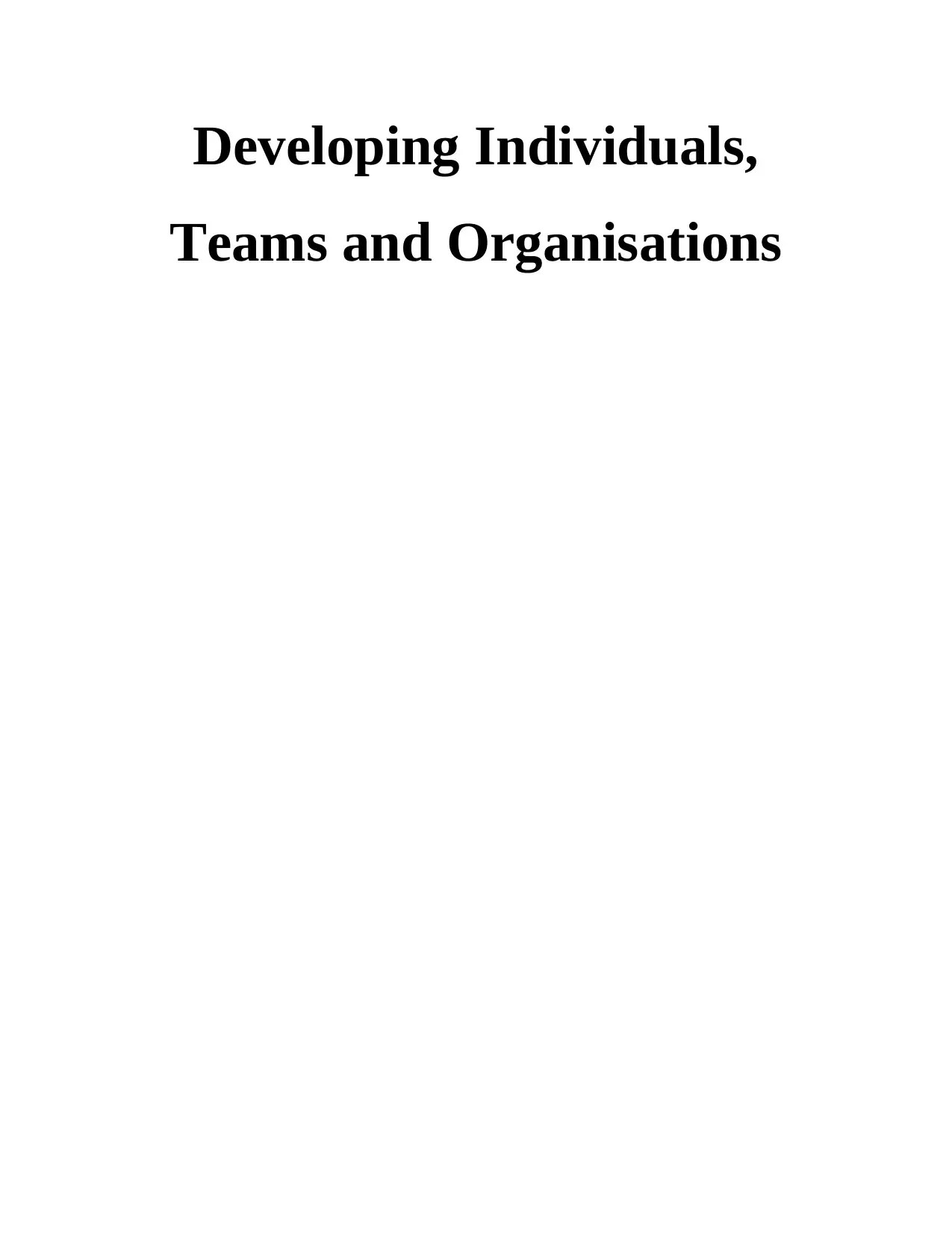
Developing Individuals,
Teams and Organisations
Teams and Organisations
Paraphrase This Document
Need a fresh take? Get an instant paraphrase of this document with our AI Paraphraser
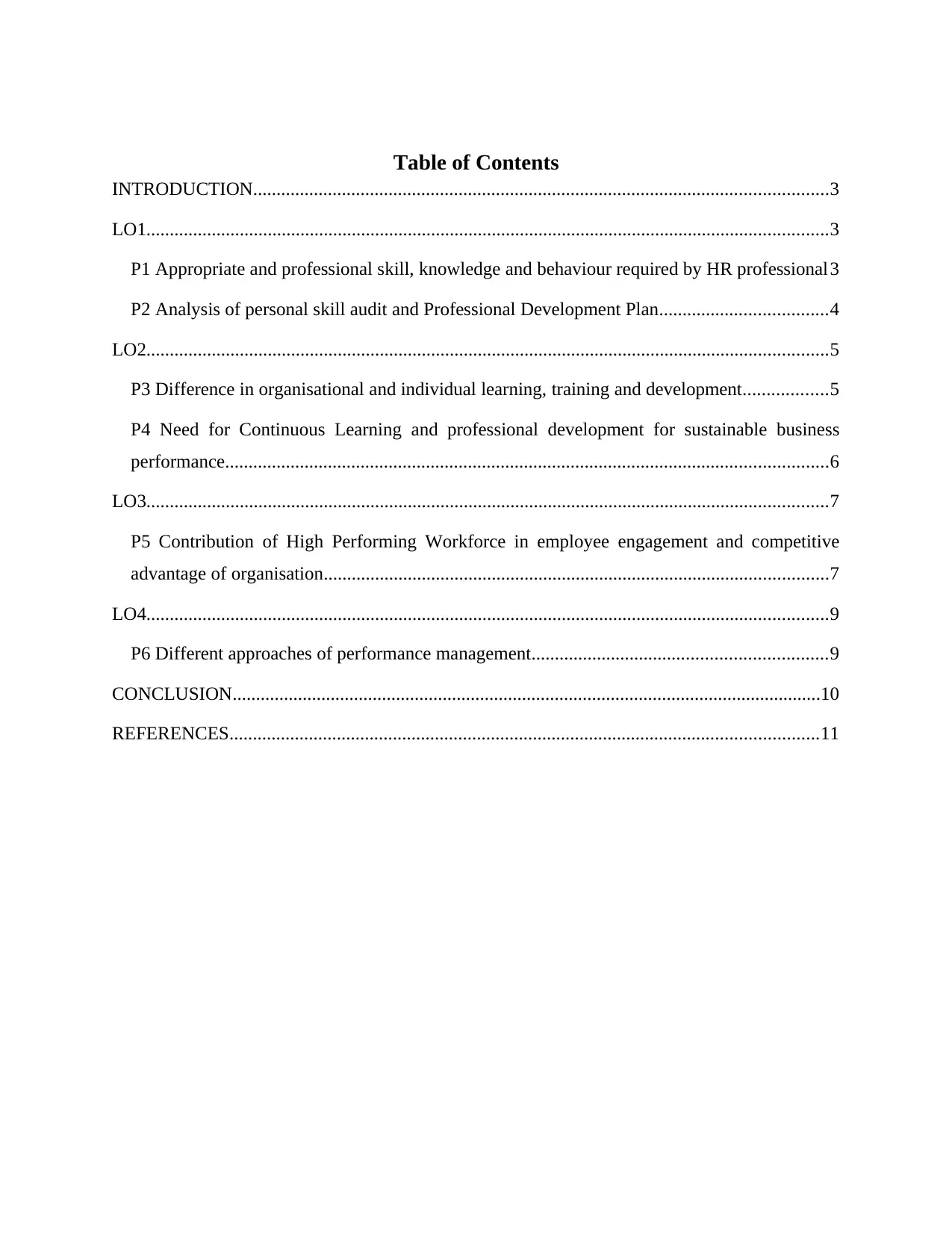
Table of Contents
INTRODUCTION...........................................................................................................................3
LO1..................................................................................................................................................3
P1 Appropriate and professional skill, knowledge and behaviour required by HR professional 3
P2 Analysis of personal skill audit and Professional Development Plan....................................4
LO2..................................................................................................................................................5
P3 Difference in organisational and individual learning, training and development..................5
P4 Need for Continuous Learning and professional development for sustainable business
performance.................................................................................................................................6
LO3..................................................................................................................................................7
P5 Contribution of High Performing Workforce in employee engagement and competitive
advantage of organisation............................................................................................................7
LO4..................................................................................................................................................9
P6 Different approaches of performance management...............................................................9
CONCLUSION..............................................................................................................................10
REFERENCES..............................................................................................................................11
INTRODUCTION...........................................................................................................................3
LO1..................................................................................................................................................3
P1 Appropriate and professional skill, knowledge and behaviour required by HR professional 3
P2 Analysis of personal skill audit and Professional Development Plan....................................4
LO2..................................................................................................................................................5
P3 Difference in organisational and individual learning, training and development..................5
P4 Need for Continuous Learning and professional development for sustainable business
performance.................................................................................................................................6
LO3..................................................................................................................................................7
P5 Contribution of High Performing Workforce in employee engagement and competitive
advantage of organisation............................................................................................................7
LO4..................................................................................................................................................9
P6 Different approaches of performance management...............................................................9
CONCLUSION..............................................................................................................................10
REFERENCES..............................................................................................................................11
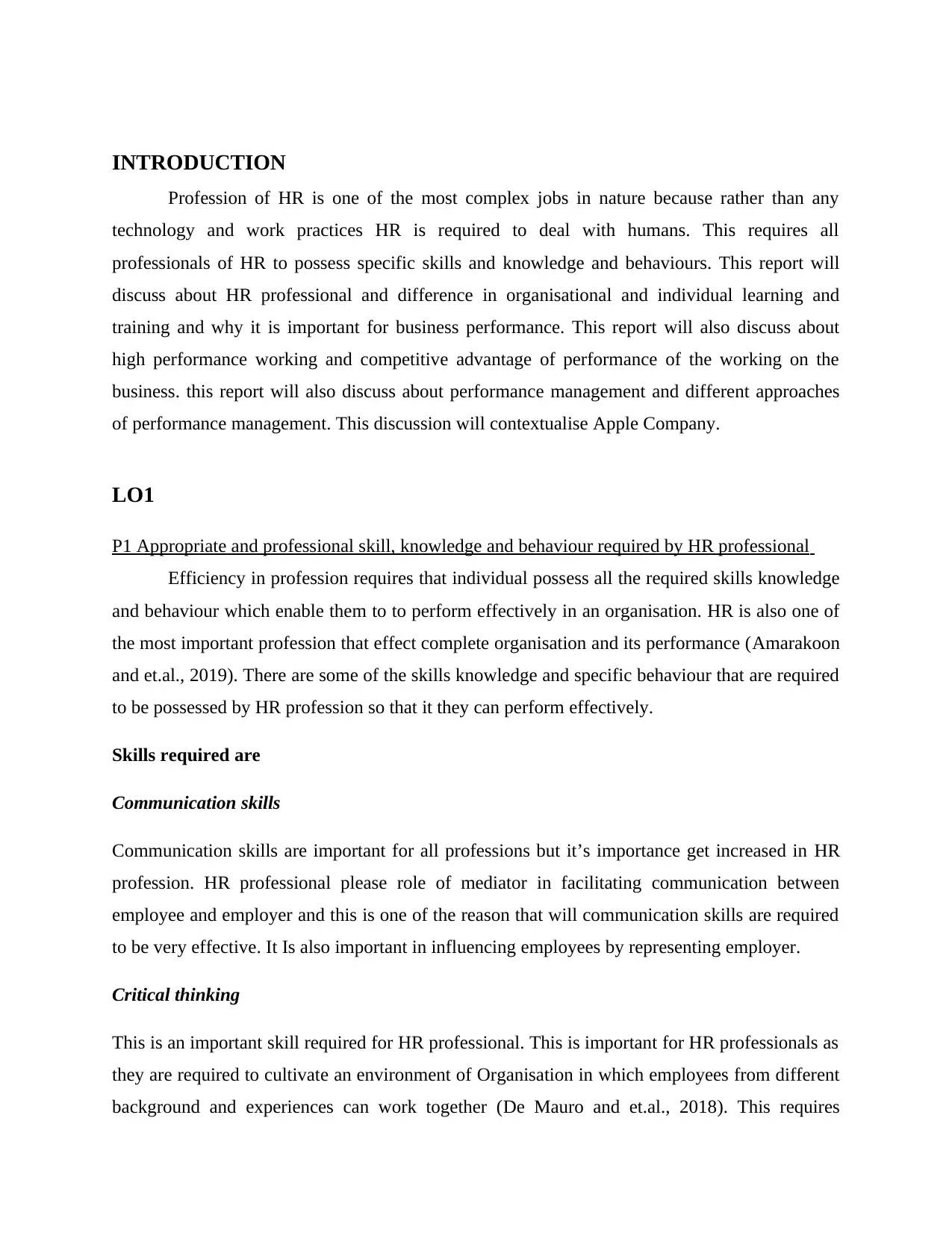
INTRODUCTION
Profession of HR is one of the most complex jobs in nature because rather than any
technology and work practices HR is required to deal with humans. This requires all
professionals of HR to possess specific skills and knowledge and behaviours. This report will
discuss about HR professional and difference in organisational and individual learning and
training and why it is important for business performance. This report will also discuss about
high performance working and competitive advantage of performance of the working on the
business. this report will also discuss about performance management and different approaches
of performance management. This discussion will contextualise Apple Company.
LO1
P1 Appropriate and professional skill, knowledge and behaviour required by HR professional
Efficiency in profession requires that individual possess all the required skills knowledge
and behaviour which enable them to to perform effectively in an organisation. HR is also one of
the most important profession that effect complete organisation and its performance (Amarakoon
and et.al., 2019). There are some of the skills knowledge and specific behaviour that are required
to be possessed by HR profession so that it they can perform effectively.
Skills required are
Communication skills
Communication skills are important for all professions but it’s importance get increased in HR
profession. HR professional please role of mediator in facilitating communication between
employee and employer and this is one of the reason that will communication skills are required
to be very effective. It Is also important in influencing employees by representing employer.
Critical thinking
This is an important skill required for HR professional. This is important for HR professionals as
they are required to cultivate an environment of Organisation in which employees from different
background and experiences can work together (De Mauro and et.al., 2018). This requires
Profession of HR is one of the most complex jobs in nature because rather than any
technology and work practices HR is required to deal with humans. This requires all
professionals of HR to possess specific skills and knowledge and behaviours. This report will
discuss about HR professional and difference in organisational and individual learning and
training and why it is important for business performance. This report will also discuss about
high performance working and competitive advantage of performance of the working on the
business. this report will also discuss about performance management and different approaches
of performance management. This discussion will contextualise Apple Company.
LO1
P1 Appropriate and professional skill, knowledge and behaviour required by HR professional
Efficiency in profession requires that individual possess all the required skills knowledge
and behaviour which enable them to to perform effectively in an organisation. HR is also one of
the most important profession that effect complete organisation and its performance (Amarakoon
and et.al., 2019). There are some of the skills knowledge and specific behaviour that are required
to be possessed by HR profession so that it they can perform effectively.
Skills required are
Communication skills
Communication skills are important for all professions but it’s importance get increased in HR
profession. HR professional please role of mediator in facilitating communication between
employee and employer and this is one of the reason that will communication skills are required
to be very effective. It Is also important in influencing employees by representing employer.
Critical thinking
This is an important skill required for HR professional. This is important for HR professionals as
they are required to cultivate an environment of Organisation in which employees from different
background and experiences can work together (De Mauro and et.al., 2018). This requires
⊘ This is a preview!⊘
Do you want full access?
Subscribe today to unlock all pages.

Trusted by 1+ million students worldwide

critical thinking regarding what are the practices that can be employed in organisation to ensure
effective performance from all the employees.
Knowledge required
Knowledge of HR practices
This means that HR professional should have knowledge regarding all the best practices in HR
full stop this becomes more important for an HR working in Apple. Knowledge regarding best
practices of recruitment and selection and payroll processing and all other practices of HR. This
is important so that HR does not affect their performance due to lack of knowledge.
Behavior required
Commitment to ongoing HR learning
This is one of important behaviour of HR because in present competitive environment of
business one cannot sustain performance on the basis of knowledge and skillslearned (Poell and
et.al., 2018). To remain competitive and sustain in performance it is important that it is a
professional is equipped with latest knowledge and practices in HR.
P2 Analysis of personal skill audit and Professional Development Plan
Personal Skill audit is one of the way through which employee can identify what skills
they possess and what they require to learn. Strength and weakness of me are as follows-
Strength
Communication Skills (both oral and written)
Time Management Skill
Weaknesses
Interpersonal Skills
Critical and Strategic Thinking
Investigative Skill
effective performance from all the employees.
Knowledge required
Knowledge of HR practices
This means that HR professional should have knowledge regarding all the best practices in HR
full stop this becomes more important for an HR working in Apple. Knowledge regarding best
practices of recruitment and selection and payroll processing and all other practices of HR. This
is important so that HR does not affect their performance due to lack of knowledge.
Behavior required
Commitment to ongoing HR learning
This is one of important behaviour of HR because in present competitive environment of
business one cannot sustain performance on the basis of knowledge and skillslearned (Poell and
et.al., 2018). To remain competitive and sustain in performance it is important that it is a
professional is equipped with latest knowledge and practices in HR.
P2 Analysis of personal skill audit and Professional Development Plan
Personal Skill audit is one of the way through which employee can identify what skills
they possess and what they require to learn. Strength and weakness of me are as follows-
Strength
Communication Skills (both oral and written)
Time Management Skill
Weaknesses
Interpersonal Skills
Critical and Strategic Thinking
Investigative Skill
Paraphrase This Document
Need a fresh take? Get an instant paraphrase of this document with our AI Paraphraser

These are some of the skills that are my strength and weakness and they are important for an HR
professional. On the basis of skills analysed and audited one of the plan for Professional
Development is as follows-
Skills to be
Developed
Objective Method for Developing Time
Interpersonal Skills To facilitate communication
and ensuring effective and
desired influence on the
person I am communicating.
This is also important for
developing new relationship
and networking
Through workshop
training
4-5 Moths-
Investigative Skill
Critical and Strategic
Thinking
Important for making
effective decisions
Practicing at Individual
level and with help of
mentor
8-10 Months
Investigative Skill Important for HR as required
in recruitment and selection
Practicing at individual
level and by guidance of
mentor
5-6 Moths
LO2
P3 Difference in organisational and individual learning, training and development
Organisational learning can be defined as learning and training which is provided by an
organisation in order to enhance performance of employees and to equip Employees with
knowledge and skill required for performing their task (Rowland, Hall and Altarawneh, 2017).
Individual learning on the other hand can be defined as a practice of training in learning which
undertaken by the employee and individual at personal level which includes learning and training
on the basis of interest rather than requirement.
Organisational learning training and development is limited to what is being required by
the employee and the game that exist between required knowledge and skill and existing
knowledge and skills of employee. Individual training learning and development however
professional. On the basis of skills analysed and audited one of the plan for Professional
Development is as follows-
Skills to be
Developed
Objective Method for Developing Time
Interpersonal Skills To facilitate communication
and ensuring effective and
desired influence on the
person I am communicating.
This is also important for
developing new relationship
and networking
Through workshop
training
4-5 Moths-
Investigative Skill
Critical and Strategic
Thinking
Important for making
effective decisions
Practicing at Individual
level and with help of
mentor
8-10 Months
Investigative Skill Important for HR as required
in recruitment and selection
Practicing at individual
level and by guidance of
mentor
5-6 Moths
LO2
P3 Difference in organisational and individual learning, training and development
Organisational learning can be defined as learning and training which is provided by an
organisation in order to enhance performance of employees and to equip Employees with
knowledge and skill required for performing their task (Rowland, Hall and Altarawneh, 2017).
Individual learning on the other hand can be defined as a practice of training in learning which
undertaken by the employee and individual at personal level which includes learning and training
on the basis of interest rather than requirement.
Organisational learning training and development is limited to what is being required by
the employee and the game that exist between required knowledge and skill and existing
knowledge and skills of employee. Individual training learning and development however
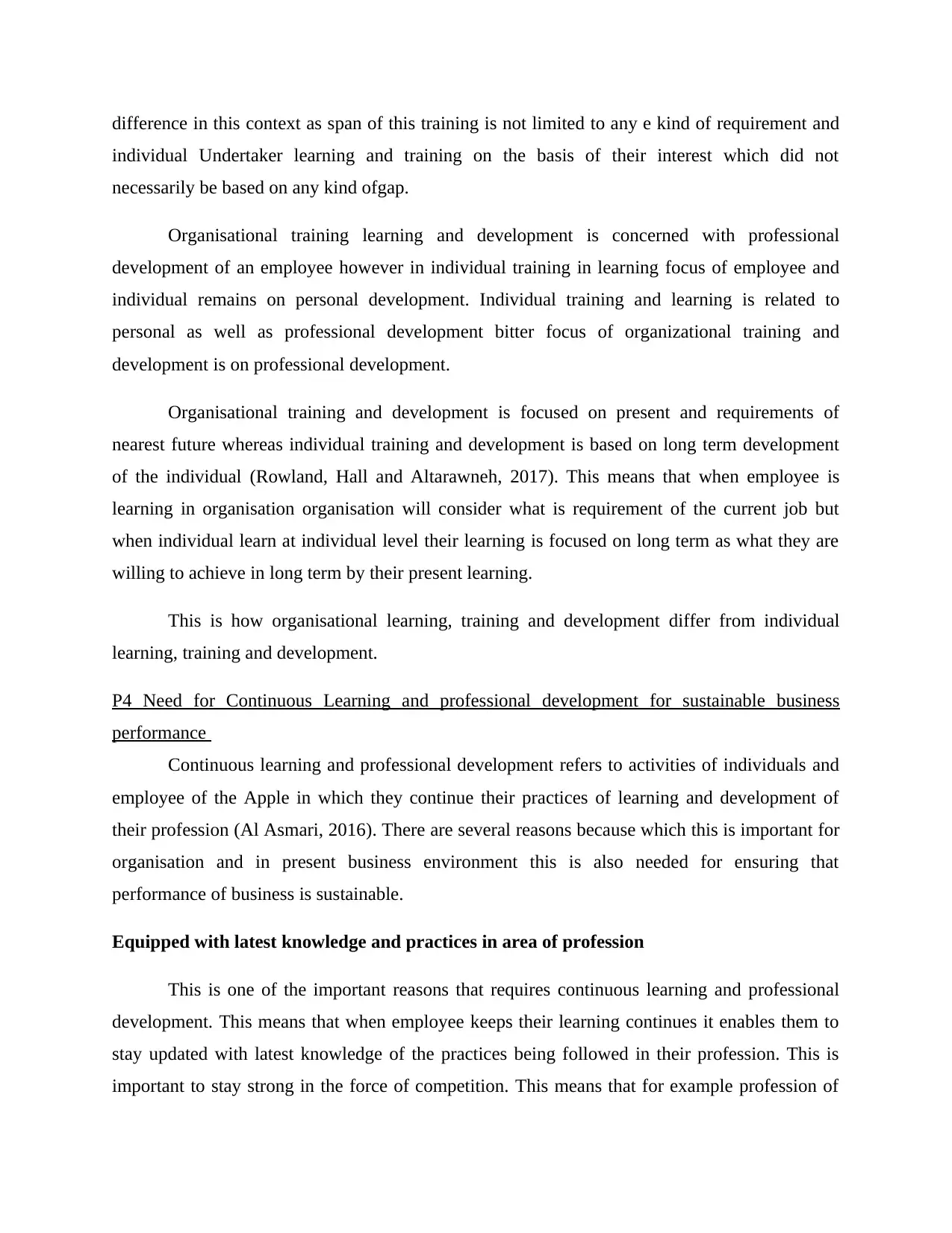
difference in this context as span of this training is not limited to any e kind of requirement and
individual Undertaker learning and training on the basis of their interest which did not
necessarily be based on any kind ofgap.
Organisational training learning and development is concerned with professional
development of an employee however in individual training in learning focus of employee and
individual remains on personal development. Individual training and learning is related to
personal as well as professional development bitter focus of organizational training and
development is on professional development.
Organisational training and development is focused on present and requirements of
nearest future whereas individual training and development is based on long term development
of the individual (Rowland, Hall and Altarawneh, 2017). This means that when employee is
learning in organisation organisation will consider what is requirement of the current job but
when individual learn at individual level their learning is focused on long term as what they are
willing to achieve in long term by their present learning.
This is how organisational learning, training and development differ from individual
learning, training and development.
P4 Need for Continuous Learning and professional development for sustainable business
performance
Continuous learning and professional development refers to activities of individuals and
employee of the Apple in which they continue their practices of learning and development of
their profession (Al Asmari, 2016). There are several reasons because which this is important for
organisation and in present business environment this is also needed for ensuring that
performance of business is sustainable.
Equipped with latest knowledge and practices in area of profession
This is one of the important reasons that requires continuous learning and professional
development. This means that when employee keeps their learning continues it enables them to
stay updated with latest knowledge of the practices being followed in their profession. This is
important to stay strong in the force of competition. This means that for example profession of
individual Undertaker learning and training on the basis of their interest which did not
necessarily be based on any kind ofgap.
Organisational training learning and development is concerned with professional
development of an employee however in individual training in learning focus of employee and
individual remains on personal development. Individual training and learning is related to
personal as well as professional development bitter focus of organizational training and
development is on professional development.
Organisational training and development is focused on present and requirements of
nearest future whereas individual training and development is based on long term development
of the individual (Rowland, Hall and Altarawneh, 2017). This means that when employee is
learning in organisation organisation will consider what is requirement of the current job but
when individual learn at individual level their learning is focused on long term as what they are
willing to achieve in long term by their present learning.
This is how organisational learning, training and development differ from individual
learning, training and development.
P4 Need for Continuous Learning and professional development for sustainable business
performance
Continuous learning and professional development refers to activities of individuals and
employee of the Apple in which they continue their practices of learning and development of
their profession (Al Asmari, 2016). There are several reasons because which this is important for
organisation and in present business environment this is also needed for ensuring that
performance of business is sustainable.
Equipped with latest knowledge and practices in area of profession
This is one of the important reasons that requires continuous learning and professional
development. This means that when employee keeps their learning continues it enables them to
stay updated with latest knowledge of the practices being followed in their profession. This is
important to stay strong in the force of competition. This means that for example profession of
⊘ This is a preview!⊘
Do you want full access?
Subscribe today to unlock all pages.

Trusted by 1+ million students worldwide

HR, when they continue their learning and professional development they will be able to
understand and learn what are the ongoing practices and what new practices and knowledge has
been developed in the profession of the HR. this can also be said that this helps organisations and
employees remain relevant.
Enhanced Confidence
Knowledge and competency is important for confidence and knowledge gives power to
confidence (Al Asmari, 2016). In this context this is very important that employees are updated
with latest knowledge and practices that give them power and confidence improves their
performance. Confidence enables people in Apple to take initiative and their decision making
also improves as they feel that they are competent to make right decisions.
Widen Perspective
This means that when employees get latest knowledge and as their knowledge get
increased their perceptions regarding situation and events get wider (Bates and Morgan, 2018).
This result in enabling individuals to thinks from extended point of view.
Creativity and Innovation
This means that knowledge is important for creativity and innovation as this fuels
thoughts of the employees and this result in enhanced performance of the employees in terms of
the creativity and innovation at Apple.
LO3
P5 Contribution of High Performing Workforce in employee engagement and competitive
advantage of organisation
High performance working can be defined as an approach for managing organisation in
which organisation aims at stimulating more effective performance of the workforce and ensure
their involvement and commitment for organisational goals. Apple also employs high
performance working in the organisation and this make important contribution in employee
engagement and competitive advantage of the Apple.
understand and learn what are the ongoing practices and what new practices and knowledge has
been developed in the profession of the HR. this can also be said that this helps organisations and
employees remain relevant.
Enhanced Confidence
Knowledge and competency is important for confidence and knowledge gives power to
confidence (Al Asmari, 2016). In this context this is very important that employees are updated
with latest knowledge and practices that give them power and confidence improves their
performance. Confidence enables people in Apple to take initiative and their decision making
also improves as they feel that they are competent to make right decisions.
Widen Perspective
This means that when employees get latest knowledge and as their knowledge get
increased their perceptions regarding situation and events get wider (Bates and Morgan, 2018).
This result in enabling individuals to thinks from extended point of view.
Creativity and Innovation
This means that knowledge is important for creativity and innovation as this fuels
thoughts of the employees and this result in enhanced performance of the employees in terms of
the creativity and innovation at Apple.
LO3
P5 Contribution of High Performing Workforce in employee engagement and competitive
advantage of organisation
High performance working can be defined as an approach for managing organisation in
which organisation aims at stimulating more effective performance of the workforce and ensure
their involvement and commitment for organisational goals. Apple also employs high
performance working in the organisation and this make important contribution in employee
engagement and competitive advantage of the Apple.
Paraphrase This Document
Need a fresh take? Get an instant paraphrase of this document with our AI Paraphraser
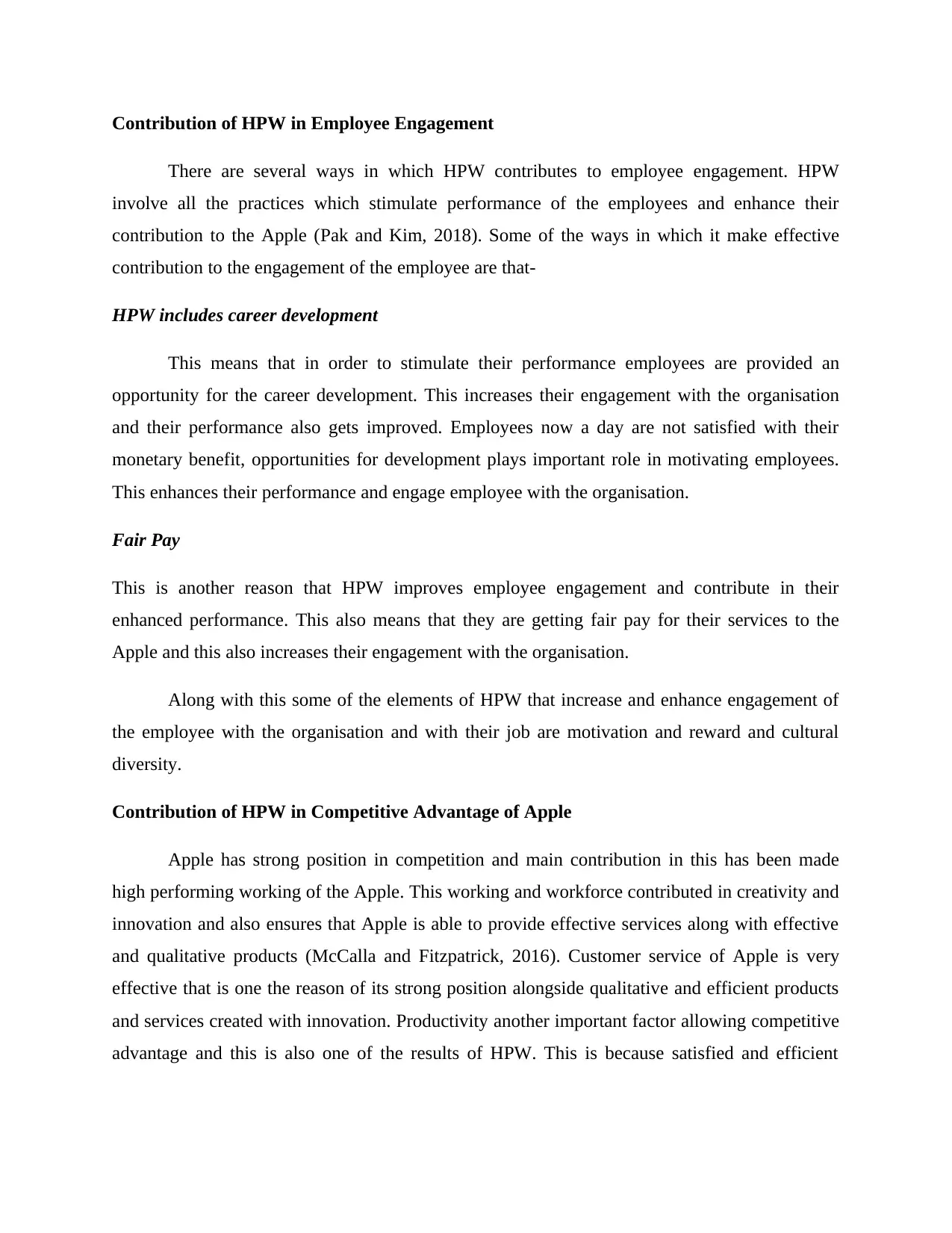
Contribution of HPW in Employee Engagement
There are several ways in which HPW contributes to employee engagement. HPW
involve all the practices which stimulate performance of the employees and enhance their
contribution to the Apple (Pak and Kim, 2018). Some of the ways in which it make effective
contribution to the engagement of the employee are that-
HPW includes career development
This means that in order to stimulate their performance employees are provided an
opportunity for the career development. This increases their engagement with the organisation
and their performance also gets improved. Employees now a day are not satisfied with their
monetary benefit, opportunities for development plays important role in motivating employees.
This enhances their performance and engage employee with the organisation.
Fair Pay
This is another reason that HPW improves employee engagement and contribute in their
enhanced performance. This also means that they are getting fair pay for their services to the
Apple and this also increases their engagement with the organisation.
Along with this some of the elements of HPW that increase and enhance engagement of
the employee with the organisation and with their job are motivation and reward and cultural
diversity.
Contribution of HPW in Competitive Advantage of Apple
Apple has strong position in competition and main contribution in this has been made
high performing working of the Apple. This working and workforce contributed in creativity and
innovation and also ensures that Apple is able to provide effective services along with effective
and qualitative products (McCalla and Fitzpatrick, 2016). Customer service of Apple is very
effective that is one the reason of its strong position alongside qualitative and efficient products
and services created with innovation. Productivity another important factor allowing competitive
advantage and this is also one of the results of HPW. This is because satisfied and efficient
There are several ways in which HPW contributes to employee engagement. HPW
involve all the practices which stimulate performance of the employees and enhance their
contribution to the Apple (Pak and Kim, 2018). Some of the ways in which it make effective
contribution to the engagement of the employee are that-
HPW includes career development
This means that in order to stimulate their performance employees are provided an
opportunity for the career development. This increases their engagement with the organisation
and their performance also gets improved. Employees now a day are not satisfied with their
monetary benefit, opportunities for development plays important role in motivating employees.
This enhances their performance and engage employee with the organisation.
Fair Pay
This is another reason that HPW improves employee engagement and contribute in their
enhanced performance. This also means that they are getting fair pay for their services to the
Apple and this also increases their engagement with the organisation.
Along with this some of the elements of HPW that increase and enhance engagement of
the employee with the organisation and with their job are motivation and reward and cultural
diversity.
Contribution of HPW in Competitive Advantage of Apple
Apple has strong position in competition and main contribution in this has been made
high performing working of the Apple. This working and workforce contributed in creativity and
innovation and also ensures that Apple is able to provide effective services along with effective
and qualitative products (McCalla and Fitzpatrick, 2016). Customer service of Apple is very
effective that is one the reason of its strong position alongside qualitative and efficient products
and services created with innovation. Productivity another important factor allowing competitive
advantage and this is also one of the results of HPW. This is because satisfied and efficient
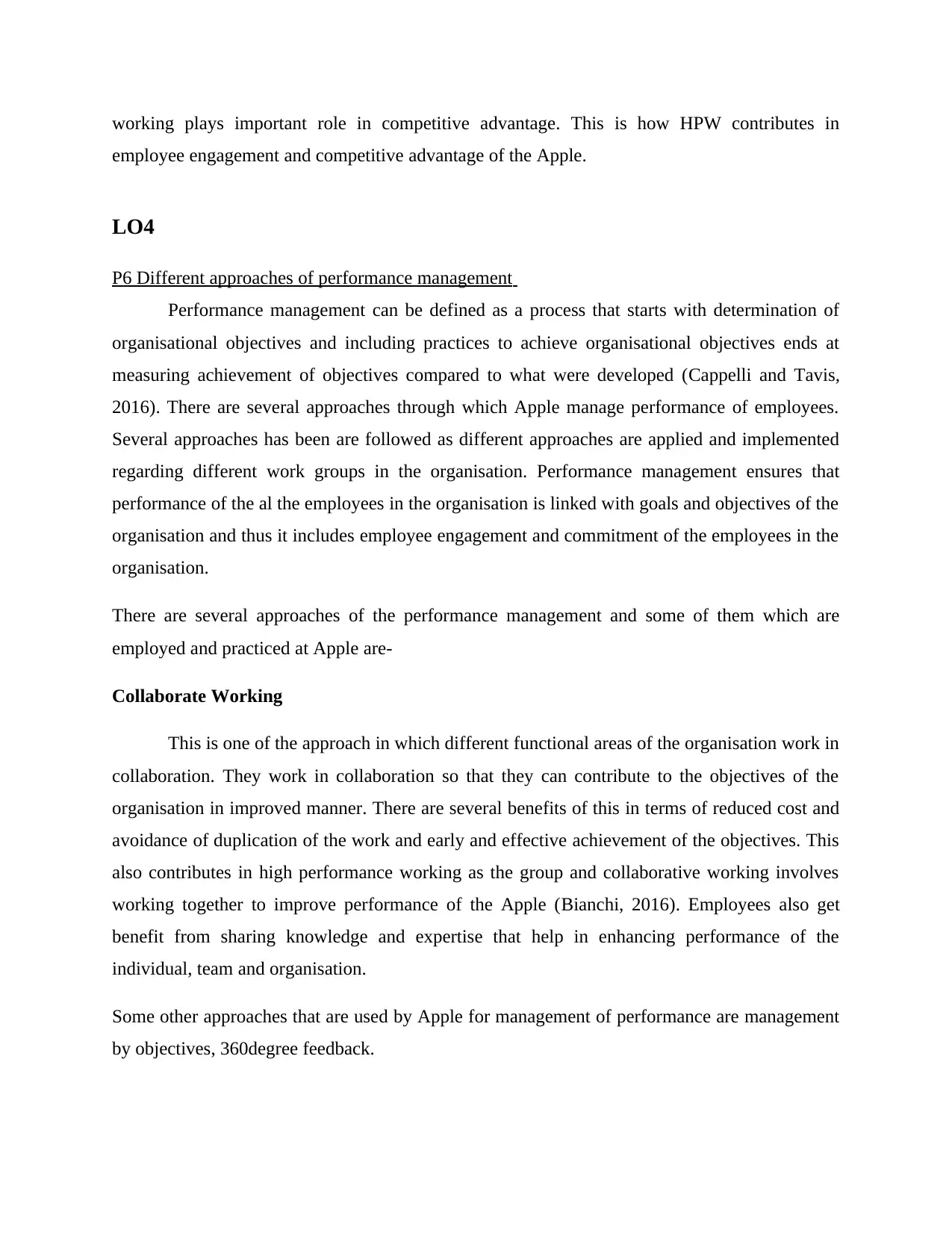
working plays important role in competitive advantage. This is how HPW contributes in
employee engagement and competitive advantage of the Apple.
LO4
P6 Different approaches of performance management
Performance management can be defined as a process that starts with determination of
organisational objectives and including practices to achieve organisational objectives ends at
measuring achievement of objectives compared to what were developed (Cappelli and Tavis,
2016). There are several approaches through which Apple manage performance of employees.
Several approaches has been are followed as different approaches are applied and implemented
regarding different work groups in the organisation. Performance management ensures that
performance of the al the employees in the organisation is linked with goals and objectives of the
organisation and thus it includes employee engagement and commitment of the employees in the
organisation.
There are several approaches of the performance management and some of them which are
employed and practiced at Apple are-
Collaborate Working
This is one of the approach in which different functional areas of the organisation work in
collaboration. They work in collaboration so that they can contribute to the objectives of the
organisation in improved manner. There are several benefits of this in terms of reduced cost and
avoidance of duplication of the work and early and effective achievement of the objectives. This
also contributes in high performance working as the group and collaborative working involves
working together to improve performance of the Apple (Bianchi, 2016). Employees also get
benefit from sharing knowledge and expertise that help in enhancing performance of the
individual, team and organisation.
Some other approaches that are used by Apple for management of performance are management
by objectives, 360degree feedback.
employee engagement and competitive advantage of the Apple.
LO4
P6 Different approaches of performance management
Performance management can be defined as a process that starts with determination of
organisational objectives and including practices to achieve organisational objectives ends at
measuring achievement of objectives compared to what were developed (Cappelli and Tavis,
2016). There are several approaches through which Apple manage performance of employees.
Several approaches has been are followed as different approaches are applied and implemented
regarding different work groups in the organisation. Performance management ensures that
performance of the al the employees in the organisation is linked with goals and objectives of the
organisation and thus it includes employee engagement and commitment of the employees in the
organisation.
There are several approaches of the performance management and some of them which are
employed and practiced at Apple are-
Collaborate Working
This is one of the approach in which different functional areas of the organisation work in
collaboration. They work in collaboration so that they can contribute to the objectives of the
organisation in improved manner. There are several benefits of this in terms of reduced cost and
avoidance of duplication of the work and early and effective achievement of the objectives. This
also contributes in high performance working as the group and collaborative working involves
working together to improve performance of the Apple (Bianchi, 2016). Employees also get
benefit from sharing knowledge and expertise that help in enhancing performance of the
individual, team and organisation.
Some other approaches that are used by Apple for management of performance are management
by objectives, 360degree feedback.
⊘ This is a preview!⊘
Do you want full access?
Subscribe today to unlock all pages.

Trusted by 1+ million students worldwide

CONCLUSION
On the basis of above discussion it can be concluded that HR professionals are required
to possess several skills that enable them to ensure their effective performance in the
organisation. This report also discussed about professional development plan on the basis of skill
audit and how the skills required can be developed. Followed by this difference between
organisational and individual training was also discussed. This report also discussed about
continuous learning and professional development and why it is needed. In this report high
performance working and performance management were also discussed. The discussion lead to
conclusion that both these are important for effective objective achievement of the organisation.
On the basis of above discussion it can be concluded that HR professionals are required
to possess several skills that enable them to ensure their effective performance in the
organisation. This report also discussed about professional development plan on the basis of skill
audit and how the skills required can be developed. Followed by this difference between
organisational and individual training was also discussed. This report also discussed about
continuous learning and professional development and why it is needed. In this report high
performance working and performance management were also discussed. The discussion lead to
conclusion that both these are important for effective objective achievement of the organisation.
Paraphrase This Document
Need a fresh take? Get an instant paraphrase of this document with our AI Paraphraser
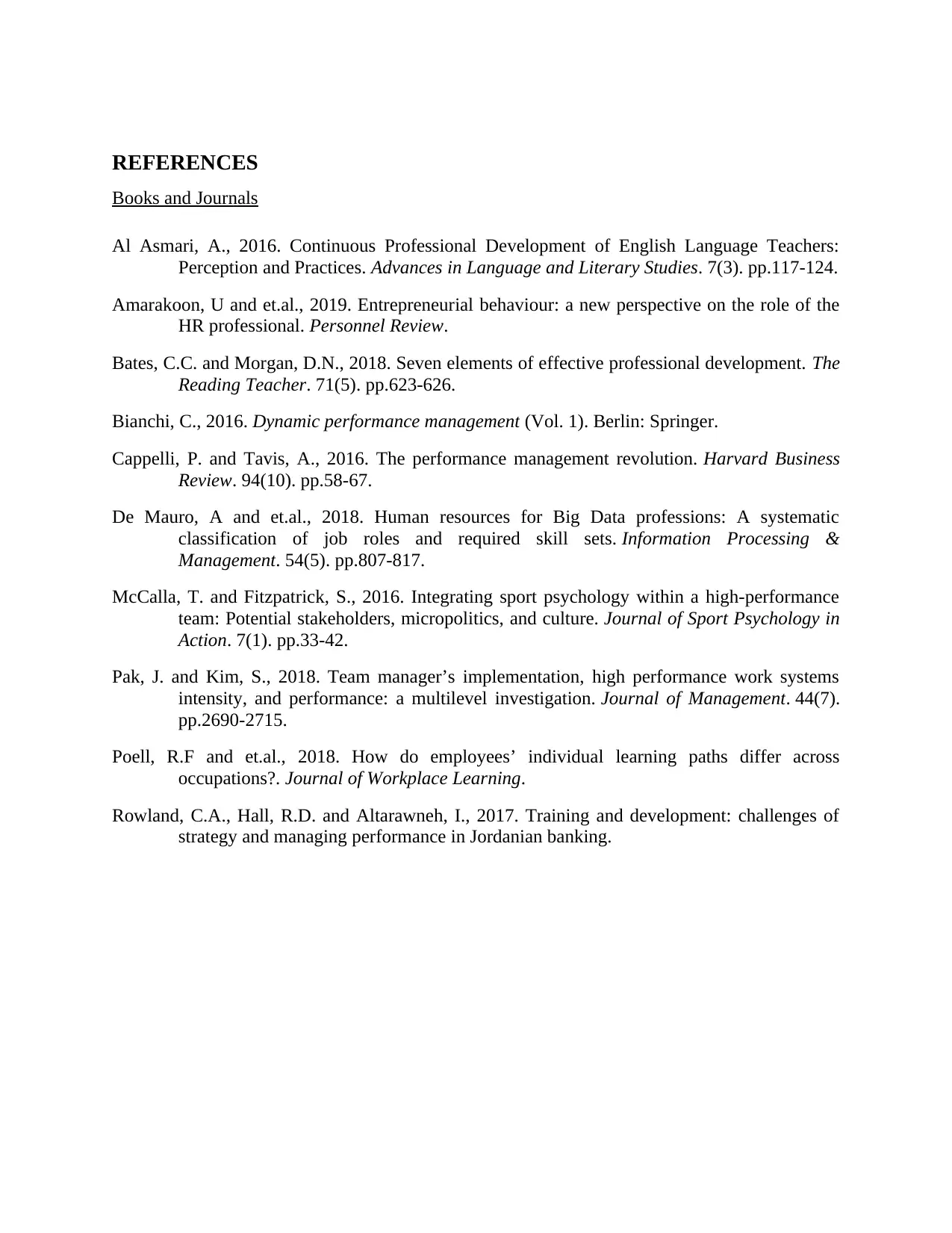
REFERENCES
Books and Journals
Al Asmari, A., 2016. Continuous Professional Development of English Language Teachers:
Perception and Practices. Advances in Language and Literary Studies. 7(3). pp.117-124.
Amarakoon, U and et.al., 2019. Entrepreneurial behaviour: a new perspective on the role of the
HR professional. Personnel Review.
Bates, C.C. and Morgan, D.N., 2018. Seven elements of effective professional development. The
Reading Teacher. 71(5). pp.623-626.
Bianchi, C., 2016. Dynamic performance management (Vol. 1). Berlin: Springer.
Cappelli, P. and Tavis, A., 2016. The performance management revolution. Harvard Business
Review. 94(10). pp.58-67.
De Mauro, A and et.al., 2018. Human resources for Big Data professions: A systematic
classification of job roles and required skill sets. Information Processing &
Management. 54(5). pp.807-817.
McCalla, T. and Fitzpatrick, S., 2016. Integrating sport psychology within a high-performance
team: Potential stakeholders, micropolitics, and culture. Journal of Sport Psychology in
Action. 7(1). pp.33-42.
Pak, J. and Kim, S., 2018. Team manager’s implementation, high performance work systems
intensity, and performance: a multilevel investigation. Journal of Management. 44(7).
pp.2690-2715.
Poell, R.F and et.al., 2018. How do employees’ individual learning paths differ across
occupations?. Journal of Workplace Learning.
Rowland, C.A., Hall, R.D. and Altarawneh, I., 2017. Training and development: challenges of
strategy and managing performance in Jordanian banking.
Books and Journals
Al Asmari, A., 2016. Continuous Professional Development of English Language Teachers:
Perception and Practices. Advances in Language and Literary Studies. 7(3). pp.117-124.
Amarakoon, U and et.al., 2019. Entrepreneurial behaviour: a new perspective on the role of the
HR professional. Personnel Review.
Bates, C.C. and Morgan, D.N., 2018. Seven elements of effective professional development. The
Reading Teacher. 71(5). pp.623-626.
Bianchi, C., 2016. Dynamic performance management (Vol. 1). Berlin: Springer.
Cappelli, P. and Tavis, A., 2016. The performance management revolution. Harvard Business
Review. 94(10). pp.58-67.
De Mauro, A and et.al., 2018. Human resources for Big Data professions: A systematic
classification of job roles and required skill sets. Information Processing &
Management. 54(5). pp.807-817.
McCalla, T. and Fitzpatrick, S., 2016. Integrating sport psychology within a high-performance
team: Potential stakeholders, micropolitics, and culture. Journal of Sport Psychology in
Action. 7(1). pp.33-42.
Pak, J. and Kim, S., 2018. Team manager’s implementation, high performance work systems
intensity, and performance: a multilevel investigation. Journal of Management. 44(7).
pp.2690-2715.
Poell, R.F and et.al., 2018. How do employees’ individual learning paths differ across
occupations?. Journal of Workplace Learning.
Rowland, C.A., Hall, R.D. and Altarawneh, I., 2017. Training and development: challenges of
strategy and managing performance in Jordanian banking.
1 out of 11
Related Documents
Your All-in-One AI-Powered Toolkit for Academic Success.
+13062052269
info@desklib.com
Available 24*7 on WhatsApp / Email
![[object Object]](/_next/static/media/star-bottom.7253800d.svg)
Unlock your academic potential
Copyright © 2020–2025 A2Z Services. All Rights Reserved. Developed and managed by ZUCOL.





